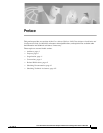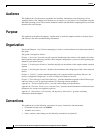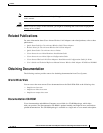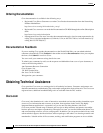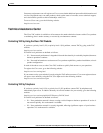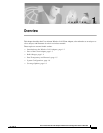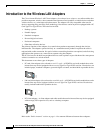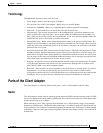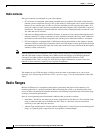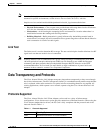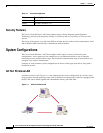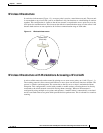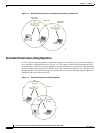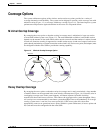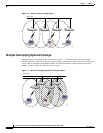
1-3
Cisco Aironet Wireless LAN Adapters Installation and Configuration Guide for MS-DOS
OL-1744-02
Chapter 1 Overview
Parts of the Client Adapter
Terminology
Throughout this document, these terms are used:
• client adapter—Refers to all three types of adapters
• PC card, LM card, or PCI client adapter—Refers only to a specific adapter
• workstation (or station)—Refers to a computing device with an installed client adapter
• End Node—A client node that is located at the end of the Network Tree.
• Infrastructure—The wireless infrastructure is the communications system that combines access
points, mobile nodes, and fixed nodes. Access points within the infrastructure can be either root
units, which are physically wired to the LAN backbone, or can act as wireless repeaters. Other RF
enabled devices serve as fixed nodes or mobile client nodes.
• Parent/Child Node—Refers to the relationships between nodes in the wireless infrastructure. The
complete set of relationships is sometimes described as a network tree. For example, the access point
(at the top of the tree) would be the parent of the end nodes. Conversely, the end nodes would be the
children of the access point.
• Power Saving Protocol (PSP) and Non-Power Saving Protocol—The Power Saving Protocol allows
computers (usually portable computers) to power up only part of the time to conserve energy. If a
client node is using the Power Saving Protocol to communicate with the network, the access point
must be aware of this mode and implement additional features such as message store and forward.
If the client node is powered from an AC line, do not use PSP.
• Repeater—A repeater is an access point that extends the radio range of the infrastructure. A repeater
is not physically attached to the wired LAN, but communicates through radio to another access
point, which is either a root unit or another repeater.
• Root Unit—The root unit is an access point that is located at the top, or starting point, of a wireless
infrastructure. A root unit provides the physical connection to the wired LAN and contains
configuration information in its association table that covers all nodes that access the wired network
(backbone). All access points directly attached to the wired LAN backbone are root units.
Parts of the Client Adapter
The client adapter is composed of three major parts: a radio, a radio antenna, and two LEDs.
Radio
The client adapter contains a direct-sequence spread spectrum (DSSS) radio that operates in the 2.4-GHz
license-free Industrial Scientific Medical (ISM) band. The radio transmits data over a half-duplex radio
channel operating at up to 11 Mbps.
DSSS technology causes radio signals to be transmitted over a wide frequency range, using multiple
frequencies simultaneously. The benefit of this technology is its ability to protect the data transmission
from interference. For example, if a particular frequency encounters noise, interference, or both, enough
redundancy is built into the signal on other frequencies that the client adapter usually is successful in its
transmission.



